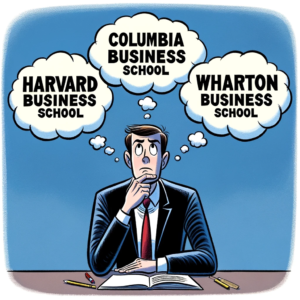
Every year, Gurufi’s consultants help applicants build compelling personal statements that get them into their dream schools. There are many ways to write a great essay, but I’ve found that the best ones are always about the future.
Unfortunately, when most people begin writing their personal statements, their first thought is what from their past they hope to highlight. After all, since you’re trying to prove that you’re qualified and prepared for an MBA, wouldn’t the natural inclination be to delve into the past, highlighting accomplishments and experiences that define your current professional identity? However, this approach, while important, only tells half the story. The key to a compelling MBA application lies not in the recollection of the past but in the clear vision of the future.
In short, if you can provide a compelling, personal, and plausible vision for your future, your application will likely succeed.
- The Future as Your Guiding Star
This is why when I run workshops to help people write personal statements, our first activity is called “Envisioning Who You Want to Become.” That’s because the starting point of your MBA application should be a forward-looking vision. It’s essential to have a concrete understanding of what and who you aim to become. This future-oriented perspective isn’t just about setting goals; it’s about envisaging a version of yourself that is more skilled, more knowledgeable, and more impactful. The clarity of this vision will not only guide your application but also your career trajectory.
Once you lay out your future in all of its specificity and ambitious glory, you need to reflect on how an MBA can bridge the gap between where you are now and where you hope to be. Understanding how an MBA will serve as a bridge from your current position to your future aspirations is crucial. It’s about recognizing the specific skills, networks, and knowledge that an MBA program can provide and how these elements are integral to achieving your long-term goals. This understanding demonstrates to the admissions committee that you have a clear purpose for pursuing an MBA, making your application more compelling.
- Contextualizing Your Past
At this point, you may be saying, “yeah, okay… but my personal statement is my past, though, right?” Yes… and no. Your future goals are central to your application, and your past experiences and achievements play a significant role in laying the groundwork. The key is to contextualize these experiences in terms of your future aspirations. Each accomplishment, challenge, and learning experience from your past should be a building block that supports your journey toward your future goals. If your past, present, and future don’t align in a way that makes sense, your essay will be incoherent. A simple question that I often ask is “does this feel like the same person?” If the events from your past that you choose to highlight don’t serve to show that you’re likely to achieve the dreams you present, that won’t make sense to the reader.
A disjointed narrative that swings between past achievements and future aspirations without a connecting thread will weaken your application and undermine the sense of theme that any good essay has. The art lies in weaving your past experiences into a narrative that flows seamlessly into your future vision. This coherence in your story not only makes your application more compelling but also demonstrates your ability to strategize and plan for long-term objectives.
- Selecting and Emphasizing Stories
When you take a future-directed mindset, the decision of which stories and accomplishments to include in your application will naturally be guided by their relevance to your future goals. Select experiences that showcase skills and qualities that are not only impressive in their own right but also pertinent to the future you envision. This selective approach ensures that every part of your application is working towards the same end goal – to showcase your potential as a future leader. Each story you include should be told with an emphasis on how it contributes to your future vision. It’s not just about what you achieved, but how those achievements have prepared you for future challenges and opportunities. A well-told story that connects your past success to your future potential can be a powerful tool in your application.
- Inspiring Confidence in Your Future
Of course, the ultimate aim of your MBA application is to convince the admissions committee that you are not only a product of your past but a promise of the future. If your application can make the reader excited about what you are set to achieve and confident in your ability to do so, your chances of admission increase significantly. In fact, a future-focused application that effectively incorporates your past experiences positions you as a candidate with immense potential. When the admissions committee sees a candidate who not only has a clear vision for their future but also a solid foundation from their past to build upon, they tend to get excited about these applicants. In my experience, these are the ones who have success.
Starting with a clear vision of what you aspire to become, understanding how an MBA will help you get there, and then using your past experiences to reinforce this narrative, creates a compelling and coherent application. By focusing on the future, you not only align your application with your long-term goals but also present yourself as a candidate who is ready to embark on the transformative journey of an MBA program. The past is your foundation, but the future is your horizon – aim for it.
If you are struggling to bring together your past and future, have the editors / consultants at Gurufi give you a hand. Our personal statement editors and consultants have decades of experience helping clients get into top MBA programs. Our specialty is helping you craft compelling personal statements that move the needle in your admissions process! For questions, shoot us an email at service@gurufi.com. Check us out on Facebook,Twitter, and LinkedIn.





